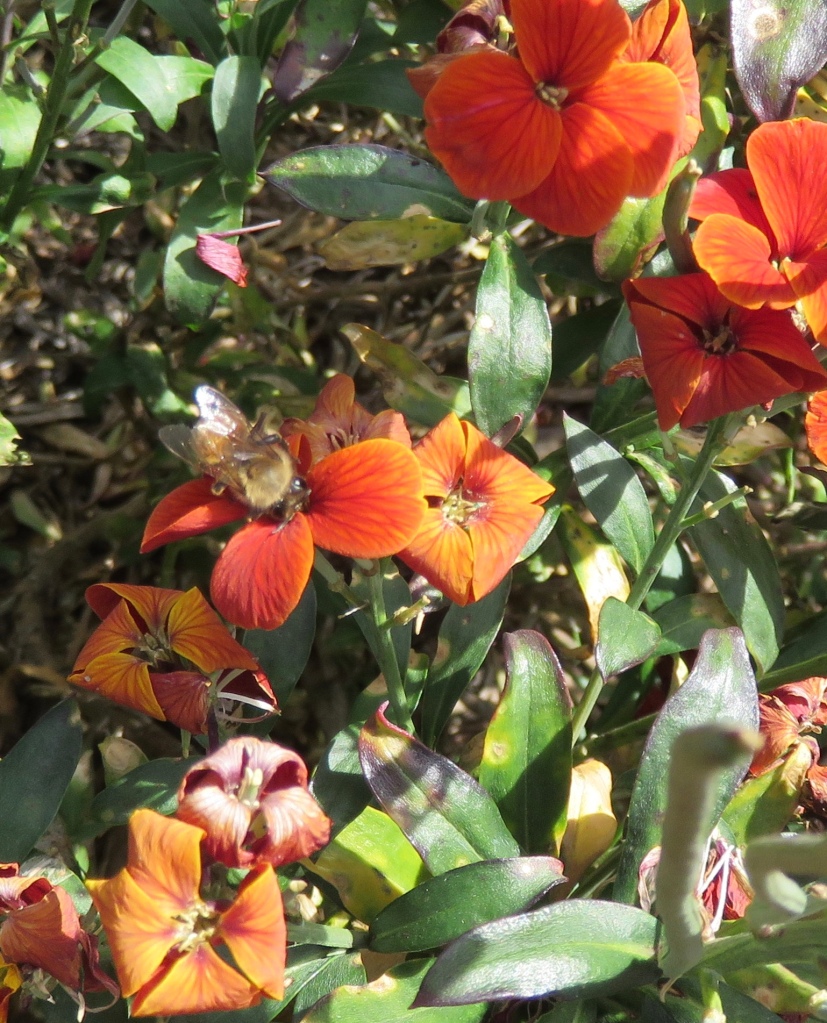I have a bee in my bonnet at the moment regarding the use of neonicotinoids in our home gardens. Neonicotinoids (such as acetamiprid, clothianidin, imidacloprid, nitenpyram, nithiazine, thiacloprid and thiamethoxam) are present in insecticide sprays and sold through garden centres and hardware stores. The use of such insecticides has been linked to bee colony collapse.
Radio NZ reported
“that a recent study by the Harvard School of Public Health found high levels of neonicotinoids in six pollen samples from New Zealand. Veteran pesticide researcher Dr Meriel Watts who now works as a consulting scientist for the United Nations and other organisations, said that was a threat to bees that the EPA has consistently refused to acknowledge. She said neonicotinoids did not stay on the seed, but were absorbed by the plant and in turn by the insects that fed on it, including bees. “They are taken up by the growing plant from the seed coating and dispersed throughout the plant throughout its lifetime,” Dr Watts said. “So they appear in the pollen, they appear in the flowers, they appear in the fruit and vegetables we eat and they appear in the little droplets of water that plants exude in the early dawn.”
Another use for this insecticide is for coating seeds. There is a useful background discussion of the issues above on – http://www.radionz.co.nz/news/national/284413/nz-urged-to-follow-us-pesticide-ban
So keep your garden safe. Spray free is so much better – let nature find the balance. I do not use these ‘quick fixes’, and have found that after a few years the soil improves so much and plants thrive better, fighting off diseases.
Earth’s life systems are more important than making money. It seems to me that these company’s inventions and their interventions in the natural balances of the planet are given precedence over the damage they do.
Poppies in our garden –
I have just visited the NZ Beekeepers Association website – http://www.nba.org.nz/learn/beneficial-plants-for-bees/
Below is their useful list for encouraging bees. Why not let your brassicas flower, and have a weed bed – or just don’t cut the lawns in places – so you build up your plant diversity. There is also information on tree species useful for bees nutrition.
Our garden is quiet at the moment, for the bees are not finding flowers to their liking; the spring flowers finished, the fruit trees have flowered, the kale and cabbages flowers gone to seed – I will have to find plants that flower now!
LIST OF NECTAR RICH PLANTS SUITABLE FOR GARDENS (they do say check on those weeds to avoid in your area)
Banksia spp.
Barberry (Berberis spp.)
Bee balm (Monarda didyma, M. citriodora)
Bottlebrush (Callistemon spp.)
Borage (Borago officinalis)
Brassicas (Brassica spp.)
Buddleia (Buddleja salviifolia)
Buttercup (Ranunculus repens)
Cabbage tree (Cordyline australis)
Californian lilac (Ceanothus spp., cvs)
Catmint (Nepeta spp.)
Coneflower (Echinacea purpurea)
Clover (Trifolium repens)
Cucumber, melon, zucchini (Cucurbita spp.)
Dahlia (Dahlia imperialis) & varieties
Echium spp.
Gum tree (Eucalyptus spp.)
Harakeke / NZ flax (Phormium tenax)
Heather (Erica spp.)
Ice plant (Sedum spectabile)
Kanuka (Kunzea ericoides)
Karo (Pittosporum crassifolium)
Kohuhu (Pittosporum tenuifolium)
Lemon, grapefruit, orange (Citrus spp.)
Koromiko (Hebe macrocarpa ) & varieties
Manuka (Leptospermum scoparium) Manatu (Plagianthus betulinus)
Kumarahou (Pomaderris kumeraho)
Lavender (Lavandula spp) & varieties
Mexican aster (Cosmos spp) & varieties
Mimosa (Acacia baileyana)
Northern rata (Metrosideros robusta)
NZ lacebark (Hoheria populnea)
NZ jasmine (Parsonsia heterophylla)
Persimmon (Diospyros kaki)
Penstemon (Penstemon spp.) & varieties
Phacelia tanacetifolia
Poached egg plant (Limnanthes douglasii)
Pohutukawa (Metrosideros excelsa)
Rewarewa (Knightia excelsa)
Rosemary (Rosmarinus officinalis)
Sage (Salvia apiana, S. fallax, S. officinalis)
and other spp.
Sneezeweed (Helenium autumnale)
Sunflower (Helianthus annuus)
Symphytum grandiflorum
Thyme (Thymus vulgaris)
Tree lucerne (Chamaecytisus palmensis)
Tulip tree (Liriodendron tulipifera)
Wharangi (Melicope ternata)
Zinnia (Zinnia spp.) & varieties


